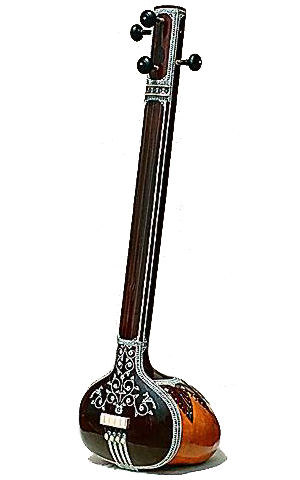India can be said to be a country of countries; its diversity of languages, religions, cultures, and traditions have no parallel example anywhere in the world. Indian musical instruments in the same manner are very diverse in nature.
Most of the Indian musical instruments have evolved over centuries. Each instrument has its own history behind its evolution. Like any other culture's evolution. In a culture's early stages, artifacts, musical Instruments, and lifestyles are simple and basic in nature. Example: all tribal instruments are basic rhythm instruments and never complex instruments having a capacity to produce a range of octaves. As a society progresses, the demands made on musical instruments rise. Thus, most Indian instruments - although having started in simple forms because of a long period of evolution - have now become exquisite instruments capable of producing a varied pitch and range of octaves. Example: Tabla must have started just as a plain drum. Below is a list of some Indian musical instruments that have gained popularity and acceptance worldwide.
SITAR
Probably the most popular string instrument from India is the sitar. String instruments have gained popularity because strings are considered to be the best accompaniment to singing, a prime element of Indian music.
A main body of the sitar is made of wood, however, the main gourd (toomba) is made of pumpkin. The pumpkin acts as a resonator or a sound box. It consists of seven main strings and 11 sympathetic strings. The frets in a sitar are curved, a brilliant innovation which helps the artist to play different scales and vary the pitch while playing the instrument by pulling the strings on the sides. Its pitch range is three or more octaves.
The origin of sitar actually goes back to Iran. It used to be called "setar" which means three strings. However, the modern sitar as we know it was developed in India in the 18th century.
TABLA
The tabla is a very popular percussion instrument of India. It consists of two drums called tabla & dagga (bayan) respectively. The treble drum (tabla) is generally made of wood and the top is covered with a stretched skin. To produce the distinct treble sound of the tabla; the artesan has to make a hard mixture in the center of the tabla ( shahi ). The skin is wrapped around the wood frame with the help of leather strings (wadi ) and round wooden blocks (gatta). The tuning is done with the help of a hammer which is struck on the gatta to tense or relax the skin. The dagga pot is generally made of brass or copper. It is the bass accompaniment of the Tabla. The tabla is about 11 inches long while the dagga is about 10 inches long.
SHEHNAI
The shehnai belongs to the woodwind family of instruments. It has double reeds to produce that characteristic vibrating sound. It is played with the fleshy parts of the fingers rather than the tips of the fingers. The shehnai is capable of producing a sound very similar to the human voice.
The outer body of the shehnai is made of wood with a metal bell at the tip of the instrument. It has a pitch range of two octaves. The melody of shehnai forms a integral part of music at Indian marriages. The shehnai is about 20 inches long.
MRIDANGAM ( PAKHAWAJ )
The mridangam belongs to the percussion family and has been played by Indians for more than 2000 years. It consists of a wooden shell approximately 27 inches long, covered with stretched skins on each side. It is famous for its distinctive buzzing sound and is used extensively for dance performances.
Mythologically it is believed that God himself created tabla and dagga by cutting the mridangam into half.
HARMONIUM
The harmonium belongs to the wind family of instruments. The basic working of a harmon-ium is a wooden box in which air is trapped with the help of bellows. There are normally two to three chambers in which metal reeds are fixed; the sound is produced when the air is forced out of the reeds. The working of the reeds is controlled by the white and black keys on the surface of the instrument. It is a constant companion for most ghazal singers.
TANPURA
A tanpura is always conspicuous by its absence. Nobody would feel the necessity of having a Tanpura till the time he would listen to any performance without it. It is also gaining popularity in meditation centers because of its beautiful, rich, soothing sound that has a very relaxing effect.
A tanpura is made of wood and has a larger base (toomba) than a sitar. The toomba, like that of sitar, is made of pumpkin. It has four strings and comes in two pitches, male and female. It is used to produce deep resonating sound to give continuity to the music and a sense of balance.
Advert.









 Reply With Quote
Reply With Quote